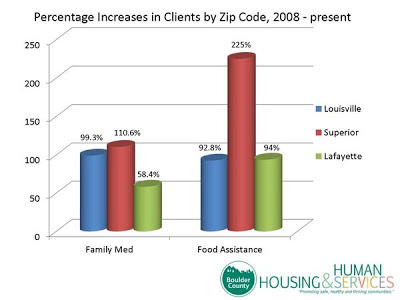No matter what you think of NBC’s “Dateline,” they have put
together a solid story on the big jump in suburban poverty since the financial
crash of 2008.
together a solid story on the big jump in suburban poverty since the financial
crash of 2008.
Reporter Izhar Harpaz focused
on the Boulder, Colo., area for his report. In particular he took at the upscale
suburbs of Superior, which was listed by Money Magazine as one of the “Top 20
best places to live in America” in 2011. Neighboring Louisville, another key subject
in the Dateline report, was ranked number one on the magazine’s list.
on the Boulder, Colo., area for his report. In particular he took at the upscale
suburbs of Superior, which was listed by Money Magazine as one of the “Top 20
best places to live in America” in 2011. Neighboring Louisville, another key subject
in the Dateline report, was ranked number one on the magazine’s list.
Here’s a portion of the story:
“Boulder County’s Department of Housing and Human
Services provided the number of Louisville and Superior residents that relied
on public safety nets to make ends meet. And while these affluent
communities still boast some of the lowest poverty levels in Colorado, the
statistics were nonetheless startling: since 2008 the combined number of
families on Medicaid more than doubled, as did the number of people utilizing
food assistance. Lafayette, another well-to-do suburb in East Boulder
County, experienced similar increases.
Services provided the number of Louisville and Superior residents that relied
on public safety nets to make ends meet. And while these affluent
communities still boast some of the lowest poverty levels in Colorado, the
statistics were nonetheless startling: since 2008 the combined number of
families on Medicaid more than doubled, as did the number of people utilizing
food assistance. Lafayette, another well-to-do suburb in East Boulder
County, experienced similar increases.
“And it isn’t just happening in Boulder County. A 2011
study by the Brookings Institute revealed that for the first time in United
States history there were more poor people living in the suburbs than in
cities. The research, based on the most recent United States Census data,
showed that a record 15.4 million suburban residents lived below the poverty
line last year, up 11.5% from the year before, and that ‘by 2010, suburbs
were home to one-third of the nation’s poor population—outranking cities (27.5
percent), small metro areas (20.5 percent), and non-metropolitan communities
(18.7 percent).’
study by the Brookings Institute revealed that for the first time in United
States history there were more poor people living in the suburbs than in
cities. The research, based on the most recent United States Census data,
showed that a record 15.4 million suburban residents lived below the poverty
line last year, up 11.5% from the year before, and that ‘by 2010, suburbs
were home to one-third of the nation’s poor population—outranking cities (27.5
percent), small metro areas (20.5 percent), and non-metropolitan communities
(18.7 percent).’
“The Brookings Institute study examined the
percentage change of suburban poor populations between 2000 and 2010 in the 95
largest metro areas in the US. It found that in 16 of them the suburban
poor population more than doubled during that time. The Denver metro area which
includes some Boulder suburbs saw an increase of 96.4%. And while many of the
suburban poor are newly arrived immigrants or transplants from the inner
cities, a significant number are formerly middle class families who have fallen
victim to the most recent recession.”
percentage change of suburban poor populations between 2000 and 2010 in the 95
largest metro areas in the US. It found that in 16 of them the suburban
poor population more than doubled during that time. The Denver metro area which
includes some Boulder suburbs saw an increase of 96.4%. And while many of the
suburban poor are newly arrived immigrants or transplants from the inner
cities, a significant number are formerly middle class families who have fallen
victim to the most recent recession.”
You can read more here.



